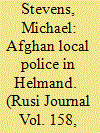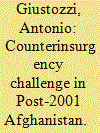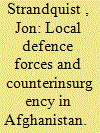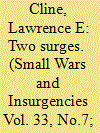| Srl | Item |
| 1 |
ID:
122234


|
|
|
|
|
| Publication |
2013.
|
| Summary/Abstract |
As the end of the British combat role in Helmand approaches, the Afghan Local Police are coming under increasing scrutiny. In the time remaining, British and US mentors are working to reinforce this fragile pillar of the Afghan National Security Forces, knowing that the potential for dramatic success is balanced against the risk of serious failure.
|
|
|
|
|
|
|
|
|
|
|
|
|
|
|
|
| 2 |
ID:
130258


|
|
|
| 3 |
ID:
152015


|
|
|
|
|
| Summary/Abstract |
Although the Taliban insurgency was internally divided and unable to coordinate its activities in 2014–2015, the Afghan security forces were not able to contain it and steadily lost ground throughout 2015. Until 2015, there had been little effort to develop an indigenous Afghan counterinsurgency strategy, but a sense of urgency emerged after a string of Taliban victories. At the beginning of 2016, it was still not clear if and when the National Unity Government would be able to produce a counterinsurgency strategy and, in any case, the need for a coherent counterinsurgency approach became questionable as the Taliban appeared to be transitioning towards conventional warfare.
|
|
|
|
|
|
|
|
|
|
|
|
|
|
|
|
| 4 |
ID:
144342


|
|
|
|
|
| Summary/Abstract |
Drawing on my fieldwork on militias in Afghanistan over the past decade, this article explores their security and political effects, with special focus on the Afghan Local Police. It analyzes changes in local security environments, effects on the Taliban insurgency and support for government, and the sustainability of and control over the militias. Key lessons include: Militias have a strong tendency to engage in abusive behavior – itself a new driver of conflict. Militias are least likely to abuse communities when they emerge spontaneously, face an abusive external force, and if major rifts and conflicts are absent from the community. Although militias might be local, their effects are not.
|
|
|
|
|
|
|
|
|
|
|
|
|
|
|
|
| 5 |
ID:
139098


|
|
|
|
|
| Summary/Abstract |
This research note makes the case that if the US and its international allies are to successfully use ‘Local Defence Forces’ (LDF) to overcome counterinsurgency constraints in Afghanistan, current initiatives need to be significantly modified. A key issue is that the Village Stability Operations/Afghan Local Police (VSO/ALP) LDF program is unlikely to be effective in filling security gaps in rural Afghanistan because, much rhetoric to the contrary, it is essentially focused on militarily combating the insurgency rather than fully developing local communities as counterinsurgency resources by winning their support for the Afghan central government. The CIA's Village Defense Program in South Vietnam, a counterinsurgency program that has thus far received cursory attention in current LDF literature, provides a useful counterpoint. Through a comparison of the VDP and VSO/ALP operational patterns, implications are drawn for current and future US counterinsurgency practice employing LDF components.
|
|
|
|
|
|
|
|
|
|
|
|
|
|
|
|
| 6 |
ID:
188336


|
|
|
|
|
| Summary/Abstract |
As the strategic environments worsened both in Iraq and Afghanistan, the US tried to improve security by sharply increasing the number of troops. In the case of Iraq, the US achieved at least operational success, but the results were seemingly minimal in Afghanistan. Two factors were critical in Iraq: surge forces were focused on a relatively small center of gravity, and the operations were greatly assisted by the rise of the Awakening movement. The additional forces in Afghanistan had a much broader geographical area for their operations, and although efforts were made to mobilize local security forces, the results were at best mixed. The public time constraints on the additional forces in Afghanistan also were more prominent, leading to a ‘good enough’ approach by necessity. Although not strictly part of the surge, the US was able to turn over more security responsibilities to Iraqi forces as the ‘clear-hold-build-transfer’ process than they were to the Afghanistan forces. The results in Afghanistan in particular lead to questions as to how well expeditionary counterinsurgency forces can succeed in widespread insurgencies.
|
|
|
|
|
|
|
|
|
|
|
|
|
|
|
|